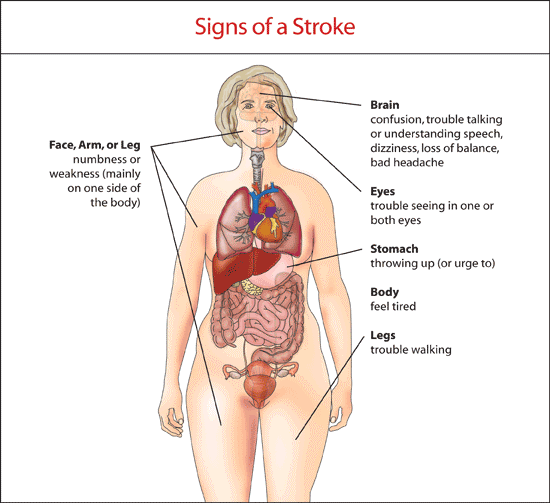Simply put, a stroke is a “brain attack.” Like a heart attack, which happens when the flow of blood is blocked from the heart, a stroke occurs when there is a lack of blood flow to your brain. When your brain doesn’t get enough blood, your brain cells start dying in just a matter of minutes. A stroke is a very serious condition, and it’s important to understand the signs of a stroke so you can be prepared to call 9-1-1 right away. Learn the signs of stroke in women and what to do.
Do Women Face a Higher Risk of Stroke?
Yes, women face a higher risk of stroke than men. Stroke is in third place for leading causes of death in women, after heart disease and cancer. Comparatively for men, stroke is in fifth place. About 55,000 more women than men have a stroke every year.
There is a broad spectrum of risk factors for stroke for everyone that includes high blood pressure, high cholesterol, diabetes, smoking, absence of exercise, and obesity. However, many women are unaware of the gender-specific risk factors they face, as well as the signs of stroke in women that are unique to only them.
- Birth Control: Women who are over 30, who smoke cigarettes, have high blood pressure, or are diabetic are particularly at risk for stroke when using oral contraceptives.
- Pregnancy: Having a normal pregnancy causes a natural rise in blood pressure, and also puts extra stress on the heart, which can increase the risk of stroke.
- Hormone Replacement Therapy: The use of Hormone Replacement Therapy (HRT), which includes progestin and estrogen, to relieve the symptoms of menopause can increase the risk of stroke.
- Atrial Fibrillation: Atrial Fibrillation is the medical term for an irregular heartbeat in the upper chambers of the heart. This arrhythmia is more common in women than men older than 75, and elderly women are much more susceptible to atrial fibrillation, which quadruples the risk of stroke.
Signs of Stroke
Understanding the signs of stroke is important for yourself and your loved ones. If you are able to recognize the signs, you will know when to call 9-1-1, or go immediately to the hospital when you see the symptoms set in.
Common Stroke Symptoms
The symptoms of stroke are also known as “suddens,” as the onset of these symptoms occurs very suddenly.
- Sudden weakness or numbness in the face, or arm, or leg, especially, but not limited to, sudden weakness or numbness on one side of the body
- Sudden confusion, difficulty speaking, or comprehension
- Sudden difficulty seeing in one or even both eyes
- Sudden trouble walking, loss of balance and/or coordination, or dizziness
- Sudden severe headache with no apparent cause
Common Symptoms in Women
It is not uncommon for women to present symptoms that are different from the common symptoms. It is important to understand these specific signs of stroke in women.
- Fainting or loss of consciousness
- General weakness
- Shortness of breath, or difficulty breathing
- Sudden change in behavior
- Agitation
- Hallucination
- Nausea and/or vomiting
- Pain
- Seizures
- Hiccups
The problem with these unique signs of stroke in women is that they are so often not recognized as a symptom of stroke right away, therefore delaying treatment. Only if a stroke is recognized and treated within three hours of onset can the most effective treatments be used.
Recognize a Stroke F.A.S.T.
F.A.S.T. is a simple way to recall the signs and symptoms of a stroke. Identifying a stroke and getting treatment fast is always ideal, and can make a huge difference in the patient’s recovery.
F.A.S.T. stands for Face, Arm, Speech, and Time:
- Face Drooping: Is one side of the face drooping or numb? You can tell if the person smiles for you.
- Arm Weakness: Is one arm weak or numb? Have the person raise both of their arms, and see if one falls down slowly.
- Speech Difficulty: Is the person slurring their speech, or unable to speak? Is it difficult to understand them? Have them repeat a simple phrase such as “the grass is green.”, can they repeat it properly?
- Time to Call 9-1-1: If the person displays any one or combination of these symptoms, call 9-1-1 right away. It is important to get them to a hospital immediately, even if their symptoms go away.

How to Prevent a Stroke in Women
Understanding the signs of stroke in women is just the first step. Prevention is possible, and with what you’ve learned here, you’re now empowered to take those measures. Some healthy stroke prevention methods include:
- Monitoring your blood pressure during pregnancy, or while taking oral contraceptives
- Getting tested for diabetes
- Monitoring your cholesterol levels
- Maintaining a healthy weight
- Quitting smoking, and other risky behaviors such as drinking
- Exercising for a minimum of 20 minutes every day
- Reporting any changes in your mood, depression is risky
- Sleeping well for about 7 to 8 hours each night
- Using olive oil for cooking because of its heart benefits
- Monitoring your headaches and seeking help for severe migraines
- Coping with stress in an effective manner
Health professionals can aid in reducing the risk of stroke in women by doing the following for their patients:
- Before prescribing oral contraceptives, screen women for high blood pressure
- For pregnant women, screen for pregnancy risk factors like preeclampsia
- Encourage women who experience migraines with aura to quit smoking
- Screening women over 75 for atrial fibrillation
